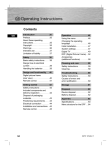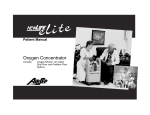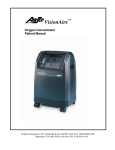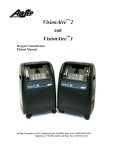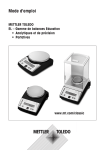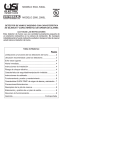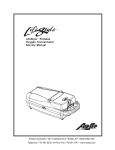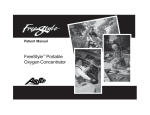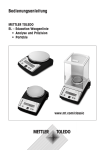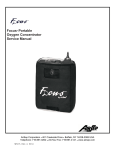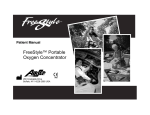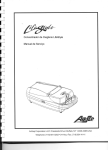Download LifeStyle Pat Man REV A
Transcript
Patient Manual LifeStyle™ Portable Oxygen Concentrator TABLE OF CONTENTS AirSep® LifeStyle™ Portable Oxygen Concentrator Why Your Physician Prescribed Oxygen 2 What Is the LifeStyle Portable Oxygen Concentrator? 3 Important Safety Rules 5 Getting Started with your LifeStyle Portable Oxygen Concentrator 8 Battery Charging and Installation Nasal Cannula 9 10 LifeStyle Unit Components 11 Operating Instructions 13 Power Supplies 14 Filters 15 Setting of the Flow Selector for Prescribed Oxygen Concentration 16 Alarm/Light Indicators 17 How to Respond to LifeStyle's Alarm/Light Indicators 20 TABLE OF CONTENTS Cleaning, Care, and Proper Maintenance AirSep® LifeStyle™ Portable Oxygen Concentrator 22 Compressor 22 Cabinet 23 Filters 24 Carrying Bag 25 LifeStyle Accessories 26 Reserve Oxygen Supply 26 Troubleshooting 27 LifeStyle Specifications 29 Classification 30 Symbols 31 Limited Warranty 32 AirSep’s LifeStyle™ Portable Oxygen Concentrator This Patient Manual will acquaint you with AirSep’s LifeStyle™ Portable Oxygen Concentrator. Make sure you read and understand all the information contained in this manual before you operate your LifeStyle unit. Should you have any questions, your Equipment Provider will be happy to answer them for you. If you observe that the LifeStyle unit is not working properly, if you feel ill or uncomfortable, or if you are unable to hear and/or feel the oxygen pulse, consult your Equipment Provider and/or your physician immediately. This unit is not to be used for life support. Geriatric, pediatric, or any other patient unable to communicate discomfort or hear or see the alarms while using this concentrator may require additional monitoring. A physician should be consulted immediately if the patient is experiencing any signs of patient discomfort. This device supplies high-purity oxygen that promotes rapid burning. Do not allow smoking or open flames within five feet of (1) this device, or (2) any oxygen-carrying accessory. Use no oil, grease, or petroleum-based products on or near LifeStyle. Disconnect the power cord from the electrical outlet before you clean or service the unit. While using the LifeStyle outdoors with the AC adapter, connect the adapter into a Ground Fault Interrupted (GFI) outlet only. LifeStyle should not be used in the rain when used outside with the AC adapter. LIFESTYLE PORTABLE OXYGEN CONCENTRATOR 1 Why Your Physician Prescribed Oxygen Many people suffer from a variety of heart, lung, and other respiratory diseases. A significant number of these patients can benefit from supplemental oxygen therapy at home, when traveling, or while participating in daily activities away from home. Oxygen is a gas that makes up 21% of the room air we breathe. Our bodies depend on a steady supply to function properly. Your physician has prescribed supplemental oxygen therapy because your body is not able to get enough oxygen from room air. Oxygen is a non-addictive drug, and your physician prescribed a flow sufficient to improve your condition. Please keep in mind that unauthorized oxygen therapy can be dangerous. You must seek medical advice before you use this oxygen concentrator. The Equipment Provider who supplies your oxygen equipment will demonstrate how to set the prescribed flow rate. It is very important to select the prescribed level of oxygen flow. Do not increase or decrease the flow until you first consult your physician. Use the LifeStyle Portable Oxygen Concentrator during sleep only under the recommendation of a qualified clinician. 2 What Is the LifeStyle Portable Oxygen Concentrator? Oxygen concentrators were introduced in the mid-1970s and have become the most convenient, reliable source of supplemental oxygen available today. Oxygen concentrators are the cost-effective, efficient, and safe alternative to using high-pressure oxygen cylinders or liquid oxygen. An oxygen concentrator produces all the oxygen you need with no cylinder or bottle deliveries required. The air we breathe contains approximately 21% oxygen, 78% nitrogen, and 1% other gases. In the LifeStyle unit, room air passes through a regenerative, adsorbent material called “molecular sieve.” This material separates the oxygen from the nitrogen. The result is a flow of high-purity oxygen delivered to the patient. The size and weight of traditional oxygen concentrators have limited their portability. A person who needs oxygen away from home or a hospital has used high-pressure oxygen cylinders and/or liquid oxygen. Oxygen conserving devices (OCDs) have been used to increase the length of time that cylinders last. OCDs deliver oxygen only at the beginning of inhalation, when oxygen is most beneficial. This time period represents one-third of the breathing cycle. Using this technique, OCDs conserve oxygen. LifeStyle uses traditional oxygen concentration technology and combines it with oxygen conserving technology. This combination enables a significant reduction in the size of the oxygen concentrator and makes LifeStyle truly portable. A typical oxygen concentrator weighs more than 50 pounds. In contrast, your LifeStyle concentrator weighs less than 10 lbs (4.5 kg). LIFESTYLE PORTABLE OXYGEN CONCENTRATOR 3 LifeStyle delivers a flow of oxygen up to an equivalent flow of 5 lpm (liters per minute) in this lightweight package that can be easily carried and used away from home. While LifeStyle is operating, it produces oxygen continuously; but oxygen is delivered only during the beginning of inhalation, when it is most beneficial. There are three ways to supply power to the LifeStyle unit: 1. From a power supply that connects to the LifeStyle unit and to a 100-250 volt, 50/60 Hz, AC outlet. The power supply also recharges the battery. 2. From an automobile’s 12-volt DC auto adapter outlet. A cord with the correct receptacle connects to the LifeStyle unit and to the DC auto adapter outlet to supply continuous power and recharge the battery. (Many boats also have a 12-volt DC auto adapter outlet.) 3. From an internal battery pack. A single, rechargeable battery pack can supply power for up to 50 minutes. 4 Important Safety Rules Carefully review and familiarize yourself with the following important safety information about the portable LifeStyle Oxygen Concentrator. In the event of an alarm or if you are experiencing any signs of discomfort, consult your Equipment Provider and/or your physician immediately. This unit is not to be used for life support. Geriatric, pediatric, or any other patients unable to communicate discomfort while using this machine may require additional monitoring. Patients with hearing and/or sight impairment(s) need assistance with monitoring alarms. When LifeStyle is in an automobile, disconnect it from the DC auto adapter outlet when the automobile is turned off. Do not allow LifeStyle to be connected to the auto adapter outlet while starting the automobile normally or while you are starting the automobile with battery-recharging cables. Wait until the automobile starts before connecting LifeStyle to the DC power outlet. (The same caution applies if using the DC adapter outlet on a boat.) LIFESTYLE PORTABLE OXYGEN CONCENTRATOR 5 Never use LifeStyle with the device itself located in the trunk of an automobile. Do not allow either the air intake/gross particle filter or the air outlet to become blocked during use. When the automobile in which you are using LifeStyle is turned off, disconnect and remove the unit from the automobile. Never allow LifeStyle to be stored in a very hot automobile or in other similar, high-temperature environments. Although LifeStyle is a low-voltage device, do not remove its housing. Only your Equipment Provider should remove the unit covers. The battery pack must be in place in the unit when operating LifeStyle. If LifeStyle will remain unused for more than five consecutive days, remove the battery pack from the device, and store it in a cool, dry place. Do not leave a nasal cannula under bed coverings or chair cushions. If LifeStyle is turned on but not in use, the oxygen could make the material flammable. Set the flow selector to the OFF position when LifeStyle is not in use. 6 AirSep recommends an alternate source of supplemental oxygen in the event of a power outage, alarm condition, or mechanical failure. Consult your physician or Equipment Provider for the type of reserve system required. Federal (USA) law restricts this device to sale by order of a physician. Use LifeStyle in accordance with AirSep’s LifeStyle Patient Manual. 7 LIFESTYLE PORTABLE OXYGEN CONCENTRATOR Getting Started with your LifeStyle Portable Oxygen Concentrator The LifeStyle box contains the following items. If any are missing, contact your Equipment Provider. • LifeStyle Portable Oxygen Concentrator • Patient manual • Air intake/gross particle filter • Rechargeable battery pack • AC adapter/power pack (100-250 volts, 50/60 Hz) • Automobile DC adapter • Adjustable shoulder strap • Carrying bag Before operating LifeStyle for the first time, allow the battery to charge for 12 hours. (Refer to the Battery Charging and Installation section.) Familiarize yourself with the locations of the major components. These are illustrated in the figures on the following pages and discussed later in this manual. 8 Battery Charging and Installation The battery must be charged before using LifeStyle. To charge the battery, connect the AC adapter to the 12 VDC inlet on the side of the LifeStyle unit (Figure 1) and into a 100-250 volt AC outlet. Allow two and one-half hours for charging the battery, unless the battery is being charged for the first time, then the battery should remain in the unit for 12 hours with the unit connected into an AC supply. The figures below show how to install and remove the battery. Insert the battery pack into the battery compartment with the arrow on top of the pack pointing away from the LifeStyle unit's handle. (See Figure 1.) To remove the battery pack, push the pack in the direction of the arrow, and lift the battery out of the battery compartment. (See Figure 2.) 9 12 VDC Inlet Figure 1: Battery Insert Figure 2: Battery Removal The battery pack must be in place in the unit when operating LifeStyle. If LifeStyle will remain unused for more than five consecutive days, remove the battery pack from the device, and store it in a cool, dry place. LIFESTYLE PORTABLE OXYGEN CONCENTRATOR Nasal Cannula A nasal cannula and tubing are used to deliver oxygen from the LifeStyle unit to the user. The tubing is connected to the unit's oxygen outlet. (See Figure 3.) AirSep recommends a nasal cannula with 7 ft (2.1 m) of tubing, AirSep Part No. CU002-1. Use of some administration accessories not specified for use with this oxygen concentrator may impair performance. 10 Figure 3: Connecting Cannula to LifeStyle's Oxygen Outlet LifeStyle Unit Components Air Inlet Air Inlet Cover Power Connection (12 VDC inlet) Air Outlet Figure 4: LifeStyle Exterior View LIFESTYLE PORTABLE OXYGEN CONCENTRATOR 11 Battery Compartment Compressor Filter Hour Meter Air Intake/ Gross Particle Filter ALARM Light BATTERY Light PULSE Light Figure 6: Additional Components 12 Rechargeable Battery Flow Selector Oxygen Outlet Handle Figure 5: LifeStyle Components Now that you are familiar with the LifeStyle’s components, review the instructions on the following page to operate the LifeStyle unit. Operating Instructions 1. Locate and position LifeStyle so that the air inlets and air outlet are not obstructed. The unit, particularly the intake area, should be located in a well-ventilated space to avoid airborne pollutants or fumes. 2. Make sure that a battery pack is in place in the unit. Then power the unit through (a) the battery; (b) a DC outlet; or (c) an AC outlet. (Refer to the "Power Supplies" section of this Patient Manual.) a. Use the battery only; or b. If you are in an automobile, connect one end of the DC auto adapter into the DC outlet and the other end into LifeStyle’s 12-volt DC connector; or c. If you are near an AC outlet, connect one end of the AC adapter into the LifeStyle’s 12-volt DC connector and the other end into the AC outlet. 3. Connect your cannula to the oxygen outlet. 4. Turn the flow selector from OFF to the setting prescribed by your physician. When you turn on the LifeStyle unit, a brief alarm sounds. This indicates that LifeStyle is powered for use. When LifeStyle senses inhalation, oxygen is supplied to you through your cannula. The duration of this pulse flow is dependent upon the flow setting. The time required to reach maximum oxygen purity after turning on the LifeStyle unit is three minutes. LIFESTYLE PORTABLE OXYGEN CONCENTRATOR 13 Power Supplies LifeStyle can be powered using three different kinds of power supplies – an AC adapter, AirSep Part No. PW005-1; an automobile DC adapter, AirSep Part No. EL204-1; and a battery pack, AirSep Part No. BT007-1. 1. AC Adapter: An AC adapter allows LifeStyle to be connected to a 100-250 volt, 50/60 Hz outlet. The adapter converts 100-250 volts AC to 13.5 volts DC for the LifeStyle unit. When LifeStyle is operated with the AC adapter, power from the AC outlet powers the unit and recharges LifeStyle’s battery simultaneously. 2. DC Auto Adapter: A DC auto adapter can be connected from the LifeStyle unit to an automobile (boat, motor home, etc.) 12-volt DC outlet. When LifeStyle is connected to the automobile’s outlet, power from the automobile battery powers the LifeStyle unit and recharges the LifeStyle’s battery simultaneously. 3. Battery Pack: A rechargeable battery pack is included with LifeStyle. When it is fully charged, it supplies power to the LifeStyle unit for approximately 50 minutes. Two different audible alarms sound when the battery power is getting low. The alarms are discussed in the Alarm/Light Indicators section of this manual. To charge the battery, connect LifeStyle to either the AC adapter and a 100-250 volt, 50/60 Hz AC power outlet or to a DC power outlet in an automobile (boat, motor home, etc.). It takes a minimum of two and one half hours for a discharged battery to fully charge. To increase the length of time that the user can be away from another power source, AirSep recommends that fully charged, spare batteries be kept with LifeStyle. When the battery begins to lose power, the user can change to a spare battery if needed. Initially, a battery must charge in the unit for 12 hours. (Refer to the Battery Charging Installation section.) The battery pack must be in place in the unit when operating LifeStyle. If LifeStyle will remain unused for more than five consecutive days, remove the battery pack from the device and store it in a cool, dry place. 14 Filters Air enters LifeStyle through an air intake/gross particle filter located on the front of the oxygen concentrator, under the unit's cover. This filter removes dust particles and other impurities from the air. Before you operate LifeStyle, make sure this filter is clean and positioned correctly. The supplemental oxygen produced by LifeStyle receives additional filtration from a product filter located within the oxygen concentrator. Your Equipment Provider performs maintenance on the product filter in addition to other maintenance of LifeStyle. The compressor filter, positioned beneath the air intake/gross particle filter, further filters the air as it enters the compressor. This filter is also maintained by your Equipment Provider. 15 The use of some oxygen administration accessories not specified for use with this oxygen concentrator may impair its performance. LIFESTYLE PORTABLE OXYGEN CONCENTRATOR Setting of the Flow Selector for Prescribed Oxygen Concentration The flow selector provided has six positions – OFF, and 1 through 5 for equivalent flows of 1-5 lpm oxygen. When operating LifeStyle, turn the flow selector to the setting that your physician has prescribed. Flow Selector 16 Figure 7: Flow Selector Setting It is very important to select the prescribed level of oxygen flow. Do not increase or decrease the flow of your prescription until you first consult your physician. Alarm/Light Indicators When the LifeStyle unit senses inhalation, a pulse of oxygen is sent through the nasal cannula. The green PULSE light displays intermittently each time a breath is detected. There are no audible alarms or other lights on during normal operation. An audible alarm sounds if LifeStyle has a low battery, senses no breathing, or if performance of the unit is outside specifications. If an alarm sounds, open the door covering the device controls to observe which lights are on. The light and audible alarm conditions are explained in detail below and summarized on the chart later in this section of the manual. • Start-Up A brief alarm sounds at start-up. LifeStyle begins to operate when the alarm stops. • Low battery As the battery power approaches a low level, a brief alarm sounds intermittently, and the yellow BATTERY light illuminates intermittently also. When this occurs, replace the battery, connect LifeStyle into a DC auto adapter outlet or an AC outlet, or change to another source of oxygen within five minutes. When LifeStyle is connected to a DC auto adapter outlet or to an AC outlet, power from the automobile battery or from the AC outlet operates the LifeStyle unit and recharges LifeStyle’s battery simultaneously. • Discharged battery LifeStyle does not produce oxygen when the battery power falls below a certain level. When this occurs, a rapid alarm sounds and the yellow BATTERY light illuminates intermittently. In this case, replace the battery, connect the LifeStyle to a DC auto adapter outlet or an AC outlet, or change to another source of oxygen immediately. When LifeStyle is connected to a DC auto adapter outlet or to an AC outlet, power from the automobile battery or from the AC outlet operates the LifeStyle unit and recharges LifeStyle’s battery simultaneously. LIFESTYLE PORTABLE OXYGEN CONCENTRATOR 17 • Battery charging The battery always charges in the unit when connected to an AC or DC power outlet, but the yellow BATTERY light illuminates only when LifeStyle is turned off. • Battery fully charged When LifeStyle is connected to an AC or DC outlet and the flow selector is turned to OFF, the yellow BATTERY light illuminates and displays continuously to indicate that the battery is fully charged. However, when charging the battery for the first time, the battery should be left in the charger for 12 hours even if the yellow light displays continuously. • No inspiration detected When LifeStyle is connected to a power source and does not sense breathing within a predetermined time period, a constant alarm sounds, and the red ALARM illuminates. If this occurs, check the connection from the cannula to the LifeStyle unit, make sure that the nasal cannula is positioned properly on your face, and ensure that you are breathing through your nose. If the alarm continues to sound, change to an alternate source of oxygen, and contact your Equipment Provider. • Performance warning The performance of LifeStyle can be affected by two conditions. The first is if the user’s breathing rate is causing the threshold of the LifeStyle unit's capacity to be exceeded. The LifeStyle unit supplies a fixed amount of high-purity oxygen. The amount of oxygen that LifeStyle supplies is dependent upon the flow selector setting and your breathing rate. If the breathing rate is too fast for the flow selector setting, the capacity of the LifeStyle unit can be exceeded. The second condition that can result in decreased performance is a general unit malfunction. LifeStyle selfmonitors performance and alerts you if this occurs. 18 If either of these events occur, a brief alarm sounds intermittently, and the red ALARM light illuminates intermittently also. During this time, LifeStyle is still producing high-purity oxygen, and you may continue to use the unit. You should reduce your activity level or consider locating another source of oxygen. Contact your Equipment Provider, as necessary. • LifeStyle’s Capacity is Exceeded If your breathing rate causes the capacity of LifeStyle to be exceeded, a rapid alarm sounds, and the red ALARM light illuminates intermittently. When this occurs, the purity of oxygen that LifeStyle is supplying is outside the unit specifications. You should change to another source of oxygen and contact your Equipment Provider. • General Malfunction If LifeStyle has a general malfunction, a rapid alarm sounds, and the red ALARM light illuminates continuously. When this occurs, the purity of oxygen that LifeStyle is supplying is outside the unit specifications. You should change to another source of oxygen and contact your Equipment Provider. LIFESTYLE PORTABLE OXYGEN CONCENTRATOR 19 How to Respond to LifeStyle's Alarm/Light Indicators Status Audible Alarm Light Indicates Action Indicator Brief, continuous, at startup (Green) PULSE; continuous light LifeStyle has been turned on. You may begin to operate your LifeStyle unit. Indicator No (Green) PULSE; intermittent light LifeStyle is delivering oxygen as a pulse flow. Continue using LifeStyle normally. Indicator No (Yellow) BATTERY; intermittent light Battery is charging. If the LifeStyle is unplugged from the power source and used, the battery does not supply power for the full 50 minutes. Indicator No (Yellow) BATTERY; continuous light (When unit is off and powered by AC or DC.) Battery is fully charged. If LifeStyle is disconnected from the AC or DC power source, the battery supplies power for a full 50 minutes. Warning Intermittent: Beep, pause, beep, pause... (Yellow) BATTERY; intermittent light Battery requires charging. Replace the battery, or connect the LifeStyle unit to a DC auto adapter outlet or an AC outlet within 5 minutes. Warning Intermittent: Beep, beep, beep, pause, beep, beep, beep... (Red) ALARM; intermittent light Breathing rate is approaching the threshold of LifeStyle's capacity; or the LifeStyle unit is approaching general malfunction. Reduce activity, and/or locate another source of oxygen. LifeStyle can still function during this condition. 20 Status Audible Alarm Light Indicates Action Alarm Continuous: Beep (Red) ALARM; continuous light No breath detected by the unit for a predetermined time period. Check the cannula connection. Ensure that you are breathing through your nose. If the alarm persists, contact your Equipment Provider. Alarm Intermittent: Beep, beep, beep... (Yellow) BATTERY; intermittent light Battery voltage is too low to operate LifeStyle. Replace the battery, or connect the LifeStyle unit into a DC auto adapter outlet or an AC outlet immediately. Alarm Rapid intermittent: Beep, beep, beep... (Red) ALARM; intermittent light Breathing rate is exceeding the capacity of the LifeStyle unit. Reduce activity, and/or locate and use another source of oxygen. Contact your Equipment Provider. General malfunction of the LifeStyle unit has occurred. Turn off the unit. Change to another source of oxygen, and contact your Equipment Provider. Alarm Rapid intermittent: Beep, beep, beep... (Red) ALARM; continuous light LIFESTYLE PORTABLE OXYGEN CONCENTRATOR 21 Cleaning, Care, and Proper Maintenance Compressor The compressor must be replaced after approximately 3,000 hours of use. When you remove the air intake/gross particle filter for cleaning, take note of the reading on the hour meter positioned beneath this filter. (See Figure 8.) When the reading approaches 3,000 hours, contact your Equipment Provider for replacement of the compressor. At this time, the Equipment Provider should also replace the product filter and felt filter. 22 Hour Meter Figure 8: Hour Meter Position Cabinet Turn off the LifeStyle unit, and disconnect the power cord from the power supply before you clean the cabinet. Keep the LifeStyle unit clean and free from moisture and dust. Clean the plastic housing periodically by wiping with a lint-free cloth or with a mild household cleaner applied with a damp cloth or sponge. Pay special attention to the oxygen outlet for the cannula connection to make sure it remains free of dust, water, and particles. Do not use liquid directly on the LifeStyle unit to clean it. A list of undesirable chemical agents includes, but is not limited to, the following, according to the plastic manufacturer: alcohol and alcoholbased products (isopropyl alcohol), concentrated chlorine-based products (ethylene chloride), and oil-based products (Pine-Sol, Lestoil). These are NOT to be used to clean the plastic housing on LifeStyle. These chemicals and the cleaners that contain them will crystallize the plastic and break down the plastic’s molecular properties. Replace the disposable cannula periodically following normal usage. Additional supplies are available from your Equipment Provider. To prevent a voided AirSep warranty, follow all manufacturer’s instructions. LIFESTYLE PORTABLE OXYGEN CONCENTRATOR 23 Filters Air Intake/Gross Particle Filter At least one time each week, wash the air intake/gross particle filter, located under the panel covering the LifeStyle unit's controls. (See Figure 9.) Your Equipment Provider may advise you to clean it more often, depending upon your operating conditions. Follow these steps to properly clean the air intake/gross particle filter: 1. Remove the filter, and wash it in a warm solution of soap and water. 2. Rinse the filter thoroughly, and remove excess water with a soft, adsorbent towel. Ensure that the filter is dry before replacing it. 3. Replace the dry filter. 24 Air Intake/Gross Particle Filter Figure 9: Air Intake/Gross Particle Filter Position Do not operate LifeStyle without the air intake/gross particle filter in place. If a second filter is provided, insert the "replacement" filter before you clean the dirty filter. AirSep does not recommend the sterilization of this equipment. Compressor (Felt) Filter and Product Filter The compressor (felt) filter and product filter must be replaced when the compressor is replaced every 3,000 hours. Your Equipment Provider will replace LifeStyle's filters and compressor. 25 Carrying Bag To clean the carrying bag and strap, brush only with warm soapy water, then allow to air dry. To prevent shrinkage, do not machine wash or dry the bag. LIFESTYLE PORTABLE OXYGEN CONCENTRATOR LifeStyle Accessories AirSep does not recommend using accessories with LifeStyle other than those listed below. Use of accessories not listed below could adversely affect the performance and/or safety of the LifeStyle Portable Oxygen Concentrator. Part No. Description BT007-1 CU002-1 EL204-1 FI109-1 MI192-2 MI194-1 MI210-1 PW005-1 Rechargeable Battery Pack Nasal Cannula with 7 ft (2.1 m) tubing DC Auto Adapter Air Intake/Gross Particle Filter Adjustable Shoulder Strap Carrying Bag LifeStyle Retractable Cart Power Pack w/appropriate AC connector Reserve Oxygen Supply 26 Figure 10: LifeStyle Retractable Cart Your Equipment Provider should provide or suggest an alternative source of supplemental oxygen therapy in case there is a mechanical failure or a power outage. During a power outage, alarm condition, or mechanical failure, use your reserve oxygen supply, and consult your Equipment Provider immediately. Troubleshooting If your LifeStyle Portable Oxygen Concentrator fails to operate properly, consult your Equipment Provider, and then refer to the troubleshooting chart on the following pages for probable causes and solutions. Do not attempt any maintenance other than the possible solutions listed below. Problem Probable Cause Solution LifeStyle does not operate when the flow selector is NOT in the OFF position. Battery is discharged. Power the unit through the DC auto adapter/outlet, or an AC adapter/outlet, or replace with a fully charged battery. Battery is not installed correctly. Remove the battery and reinsert it, ensuring that it is in the correct position. Malfunction. Contact your Equipment Provider, and change to a reserve oxygen supply. LifeStyle has not detected a breath for a predetermined time period. Check the cannula connection. A continuous alarm sounds and the (red) ALARM light illuminates continuously. Ensure that cannula tubing is not kinked. Make sure that the cannula is positioned properly and that you are breathing through your nose. LIFESTYLE PORTABLE OXYGEN CONCENTRATOR 27 Problem Probable Cause Solution Intermittent alarm condition (1-second warning sounds every 5 seconds), and the (yellow) BATTERY light illuminates intermittently. Battery requires charging. Replace battery or connect to a DC or an AC outlet within 5 minutes. Rapid alarm condition (½-second alarm sounds every ½ second), and the (yellow) BATTERY light illuminates intermittently. Battery voltage is too low to operate the LifeStyle unit. Replace battery or connect to a DC or an AC outlet immediately. Rapid alarm/pause/alarm condition (three ½-second warnings sound every 5 seconds), and the (red) ALARM light illuminates intermittently. Breathing rate is approaching the threshold of the LifeStyle unit's capacity. Reduce activity, and consider locating another source of oxygen. A general malfunction could be imminent. Reduce activity, and consider locating another source of oxygen. Rapid alarm condition (½-second alarm sounds every ½ second), and the (red) ALARM light illuminates intermittently. Breathing rate has exceeded the capacity of the LifeStyle unit. Change to another source of oxygen, and contact your Equipment Provider. Rapid alarm condition (½-second alarm sounds every ½ second), and the (red) ALARM illuminates continuously. A general malfunction has occurred. Change to another source of oxygen, and contact your Equipment Provider. All other problems. Change to another source of oxygen, and contact your Equipment Provider. 28 LifeStyle Specifications Oxygen Concentration:* Set at 1-5 lpm: equivalent to a continuous flow of 90% oxygen ± 3% Dimensions: 5.5 in. high x 7.25 in. wide x 16.31 in. long (13.9 cm high x 18.4 cm wide x 41.4 cm long) Weight: 9.75 lb (4.4 kg) Power: LifeStyle unit – Power supply – Battery pack – Battery duration: 50 minutes nominal for fully-charged battery Battery quick-charge: 2-2 1/2 hours Warm-up time: 3 minutes Audible alarms and visual indicators: Start-up – audible and visual (GREEN indicator light) Pulse flow – visual (GREEN pulse light) Battery condition – audible and visual (YELLOW indicator, warning, and alarm lights) No breath detected – audible and visual (RED alarm light) System overdraw – audible and visual (RED warning and alarm lights) High and low pressure – audible and visual (RED alarm light) Sound: Less than 55 decibels Temperature range: Operational temperature: Storage temperature: 13 VDC, 42 watts 100–250 VAC, 50/60 Hz, 2.0 amps max 12 VDC, nominal 29 41oF to 104oF (5oC to 40oC) -4oF to 140oF (-20oC to 60oC) - unit only 41oF to 95oF (5oC to 35oC) - battery only *Based on an atmospheric pressure of 14.7 psia (101 kPa) at 70°F (21°C) LIFESTYLE PORTABLE OXYGEN CONCENTRATOR Classification Type of protection against electric shock: Class II Protection from electric shock is achieved by double insulation. Degree of protection against electric shock: Type BF Equipment providing a particular degree of protection against electric shock regarding 1) allowable leakage current; 2) reliability of protective earth connection (if present). Not intended for direct cardiac application. Independent testing for Medical Electrical Equipment Standard : Tested by UltraTech Group of Labs to be in compliance with IEC 60601-1:1988 + A1:1991, A2:1995 Protection against potential electromagnetic or other interference between the equipment and other devices: Tested by UltraTech Group of Labs to be in compliance with IEC 601-1-2 (EMC) Method of cleaning and infection control allowed: Please refer to the “Cleaning, Care, and Proper Maintenance” section of this LifeStyle Patient Manual. Degree of safety of application in the presence of flammable anesthetic gases: Equipment not suitable for such application. Mode of operation: Continuous duty 30 Symbols Symbols are frequently used on equipment in preference to words with the intention of decreasing the possibility of misunderstanding caused by language differences. Symbols can also permit easier comprehension of a concept within a restricted space. The following table is a list of symbols and definitions used with the LifeStyle Portable Oxygen Concentrator. Symbol Description Warning Caution ! Refer to Patient Manual instructions Note No oil No smoking Type BF equipment Class II CE mark LIFESTYLE PORTABLE OXYGEN CONCENTRATOR 31 Limited Warranty AirSep Corporation warrants the LifeStyle Oxygen Concentrator to be free from defect in parts for two years (as specified on the original invoice provided) from the date of delivery to the original purchaser, under normal use and operation. The battery is warrantied for 90 days. AirSep Corporation’s obligations under this warranty are limited to the repair or replacement of any such item of equipment (or part thereof) shown to be defective or, at AirSep Corporation’s option, to refund the purchase price of any such defective item of equipment. Each item of equipment for which a warranty claim is asserted shall, at the request of AirSep Corporation, be returned on a prepaid basis with proof of purchase date to the AirSep factory at the expense of the purchaser. The purchaser will be responsible for return freight charges. Replacement parts shall be warranted as stated above for the unexpired portion of the original two-year parts warranty (as specified on the original invoice provided). This warranty does not extend to any item or part subjected to misuse, accident, improper maintenance, or application, or which has been repaired or altered outside of the AirSep Corporation factory without the express prior written authorization of AirSep Corporation. THE FOREGOING WARRANTY IS IN LIEU OF ANY OTHER WARRANTY, EXPRESSED OR IMPLIED, IN FACT OR IN LAW, INCLUDING WITHOUT LIMITATION THE WARRANTY OF MERCHANTABILITY OR THE WARRANTY OF FITNESS FOR PARTICULAR PURPOSE. IT IS EXPRESSLY UNDERSTOOD THAT PURCHASER’S SOLE AND EXCLUSIVE REMEDY FOR DEFECT IN PARTS IS LIMITED TO ENFORCEMENT OF AIRSEP CORPORATION’S OBLIGATION AS SET FORTH ABOVE, AND AIRSEP CORPORATION SHALL NOT BE LIABLE TO PURCHASER OR OTHERS FOR LOSS OF USE OF THE EQUIPMENT OR FOR OTHER SPECIAL, INDIRECT, INCIDENTAL, OR CONSEQUENTIAL DAMAGES. 32 European Representative: GavinAyling 9 Bungham Lane Penkridge Stafford Staffordshire ST19 5NH England Tel/Fax: 44-1785-712636 For service on your LifeStyle Portable Oxygen Concentrator, please contact: Manufactured by: AirSep Corporation Buffalo, NY 14228-2085 USA MN104-1 Rev D 12/04









































